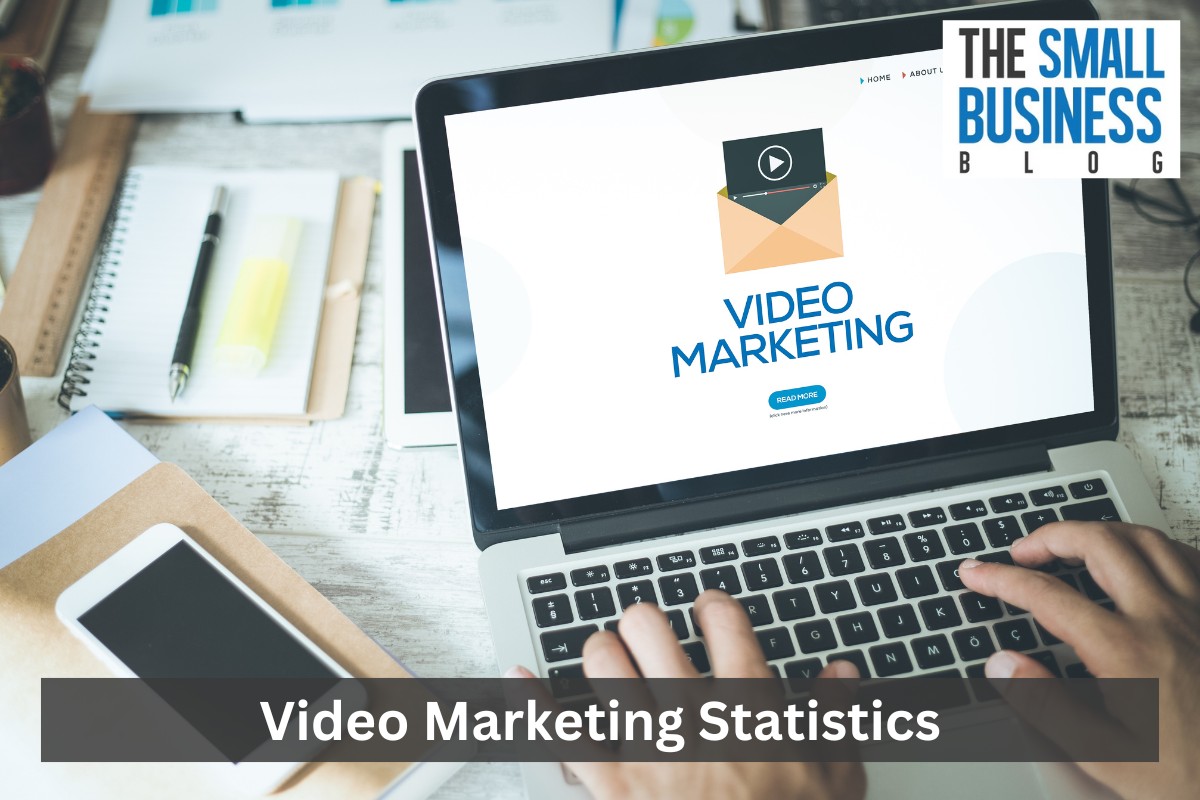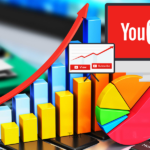Videos have become one of the most powerful marketing tools for any business.
The right video can reach millions of people.
It can portray powerful messages and, best of all, people are more likely to remember a video.
Research suggests that the human brain absorbs information 60,000 times faster from an image or video than it does from a block of text.
In other words, one short video can be better at promoting a business than hundreds of text-based adverts.
As the following video marketing statistics show, there has never been a better time to launch a video marketing campaign.
It’s not just easier than ever to create videos, the explosion in social media use means it’s possible to reach your target audience instantly.
Let’s get straight into it.
Post Contents
- 1 Key Statistics
- 2 Top Video Marketing Statistics in 2024
- 2.1 1. In 2020 There Were Nearly 250 Million Digital Video Viewers In The US
- 2.2 2. 91% Of Consumers Feel More Video Content Should Be Launched
- 2.3 3. 86% Of Businesses Already Use Video Marketing
- 2.4 4. 66% Of Viewers Prefer Short Videos
- 2.5 5. YouTube Ranks Top For Marketing
- 2.6 6. 80% Of People Purchase After Watching A Brand Video
- 2.7 7. On Average, People Spend 6 Hours 48 Minutes Per Week Watching Videos Online
- 2.8 8. 82% Of Internet Traffic Is Video Related
- 2.9 9. Lack Of Knowledge Is the Main Reason Businesses Aren’t Using Video Marketing
- 2.10 10. 70% Of Those Not Currently Using Video Marketing Intend To Start Soon
- 2.11 11. 92% Of Video Marketeers Report Positive ROI
- 2.12 12. 96% Of Businesses Are Confident Videos Help Consumers Understand Their Product
- 2.13 13. 63% Of Marketers Rate Number Of Views As The Most Important Factor
- 2.14 14. 52% Of Video Marketing Professionals Feel Videos Improve Trust
- 2.15 15. The Average Marketing Video Costs $2,500
- 3 Types Of Content
- 4 Summing Up
Key Statistics
- In 2020 there were nearly 250 million digital video viewers in the US.
- 91% of consumers feel more video content should be launched.
- 86% of businesses already use video marketing.
- 66% of viewers prefer short videos.
- YouTube ranks top for marketing.
- 80% of people purchase after watching a brand video.
- On average, people spend 6 hours 48 minutes per week watching videos online.
- 82% of internet traffic is video related.
- Lack of knowledge is the main reason businesses aren’t using video marketing.
- 70% of those not currently using video marketing intend to start soon.
- 92% of video marketeers report positive ROI.
- 96% of businesses are confident videos help consumers understand their product.
- 63% of marketers rate number of views as the most important factor.
- 52% of video marketing professionals feel videos improve trust.
- The average marketing video costs $2,500.
Top Video Marketing Statistics in 2024

1. In 2020 There Were Nearly 250 Million Digital Video Viewers In The US
A survey by Business Insider in 2021 showed that over 244 million people were watching videos in the US on a regular basis.
That’s two-thirds of the population.
This represented a significant increase from the previous survey, much more than industry experts predicted.
Of course, the global pandemic is one contributing factor as people are stuck at home trying to kill time.
Interestingly, many of the new digital video viewers were in the younger age groups.
That’s not particularly surprising.
However, it was those older than 65 who seemed to drive the largest part of the increase in video content watching.
Of course, overall, 90% of viewers are aged between 12 and 44, illustrating just how popular videos are with the younger generation.
However, 63.8% of people older than 65 are now watching video content.
(Business Insider)
2. 91% Of Consumers Feel More Video Content Should Be Launched
Millions of videos are created every day.
It’s estimated that 3.7 million videos are uploaded daily just to YouTube.
That’s a lot of content.
The latest study from Wyzowl suggests that even this isn’t enough.
91% of those asked would like to see more videos created by their favorite brands.
This figure was 85% in 2018.
That shows entertainment isn’t the only or even the driving factor behind video creation.
Consumers want more videos to ensure they feel connected to specific brands and are confident in how to use their products.
In other words, high-quality marketing videos are essential if you want to remain competitive.
Consumers are increasingly paying attention to video and businesses need to embrace this if they want to flourish.
(Wyzowl)
3. 86% Of Businesses Already Use Video Marketing
Marketing tactics have evolved in recent years.
Cold-calling and other strong-arm tactics have become a thing of the past.
Businesses which want to be successful and recognized need to adopt the modern approach.
At present, this revolves around making videos.
The Wyzowl survey shows that most businesses are aware of this fact, 86% of them are already using videos to promote their business.
In fact, that was the 2021 figure, it seems likely that this figure is closer to 91% for 2022.
The reason video content has become so popular with professionals is that they feel it gets results.
78% of marketers say video increases sales, and a further 86% state it has increased the traffic to their website.
(Wyzowl)
4. 66% Of Viewers Prefer Short Videos
Recent statistics show that mobile devices have overtaken desktops as the most popular way to access the internet.
Mobiles allow consumers to get online anywhere, at any time.
However, this ease of access has also changed the content being viewed.
It’s much easier to watch a video while commuting than read an article.
The fact that people often hop on the internet just for a few moments also means that the content needs to be short.
This is reflected in the latest Wyzowl survey results as they show 66% of consumers prefer short videos.
These respondents also stated they will pay more attention to a short video and are more likely to watch the entire thing.
Specifically, the video should be under 30 seconds.
Interestingly, 30 seconds is a great target for YouTube and Instagram, Facebook viewers tend to watch for longer.
Content between 2-5 minutes long is generally well received.
(Wyzowl)
5. YouTube Ranks Top For Marketing
Creating videos is one thing, but businesses need to know where to place the video to get the maximum exposure and best possible results.
According to the latest survey by Wyzowl that means using YouTube.
The survey found that 89% of marketers favored YouTube when posting videos.
This is because it is a dedicated video platform and has billions of users.
While many businesses post videos in several locations, nine out of 10 marketers feel that YouTube is the most important place to start.
Facebook follows with 70% of marketing professionals committed to adding content on this social media site.
That’s not surprising as it has over 3 billion users.
What may surprise you is that Twitter and even Instagram don’t take the third spot.
63% of marketers feel that LinkedIn is the best place for their content videos and intend to post more on the site.
(Wyzowl)
6. 80% Of People Purchase After Watching A Brand Video
Videos are generally made to be fun and informative.
Boosting brand awareness and trust are essential outcomes to ensure your business is thought of when they need something.
Of course, businesses also invest money in creating videos and hope to generate sales from the process.
Fortunately, a recent survey by Wyzowl highlighted how effective videos are at creating sales.
While all videos can generate sales, a brand video which promotes a specific product will generally result in eight out of 10 people buying the product.
That’s an impressive 80% conversion rate and highlights why video marketing is becoming an essential part of business promotion.
The same study also highlighted the importance of how-to videos.
It showed that 96% of buyers will watch videos first to check the relevance and ability of the product.
This approach is also adopted by Google which sees a video as a way to remind you of the items you need on your shopping list.
(Wyzowl)
7. On Average, People Spend 6 Hours 48 Minutes Per Week Watching Videos Online

The amount of time people spend watching videos is consistently growing.
Recently, surveys showed that people are now ditching traditional television in favor of watching videos.
With such a huge array of videos online, it’s comparatively easy to find something which will appeal more than traditional TV.
A 2019 survey showed that the average person spends six hours and 48 minutes looking at online videos, every week.
That’s a significant amount of time and a 59% increase on the 2016 figure.
The signs suggest this trend will continue and an increasing number of people will ditch traditional television.
The average daily global video consumption is 84 minutes.
It’s China and Sweden which are leading the video consumption charge.
Their citizens spent an average of 103 minutes watching online videos every day in 2019.
(Limelight)
8. 82% Of Internet Traffic Is Video Related
Open any internet page and you’re almost certain to see some video content mixed with articles and images.
Videos are easy to watch anywhere, informative, and generally more fun than reading a long article.
The video can supply the same information in a fraction of the time.
The 2019 Cisco report found 82% of global internet traffic is connected with videos, whether live streaming or downloading.
In 2017 the percentage was just 72.3%.
The increase is staggering and looks set to continue.
It’s worth noting that videos in all formats are popular.
However, live-streaming videos have seen an impressive increase in popularity.
An impressive 17% of all internet traffic can be attributed to live-stream videos!
That’s worth noting if you are running, or planning to run an eCommerce business.
(Cisco)
9. Lack Of Knowledge Is the Main Reason Businesses Aren’t Using Video Marketing
As of 2023, approximately 10% of businesses are still not using video marketing.
That’s despite its obvious benefits.
However, there are good reasons why this is the case and they revolve around a lack of knowledge on the subject.
For example, the Wyzowl survey 2022 found that 30% of businesses feel they don’t have enough time to create videos, showing a lack of knowledge regarding how easy it is to make a simple introductory video.
A further 18% have no idea how to start making and releasing video content.
Interestingly, 10% of marketing professionals have been unable to convince those in charge that video content is an essential part of marketing.
The survey showed 10% of marketers still believe that video content is too expensive and doesn’t get a good ROI.
However, the most surprising fact is that 8% of those not using video content don’t feel it is necessary.
(Wyzowl)
10. 70% Of Those Not Currently Using Video Marketing Intend To Start Soon
It’s surprising, but for a variety of reasons, some businesses are not yet using video marketing as a tool to help boost sales and brand recognition.
A recent survey showed that this is changing.
70% of those not currently using video content intend to start using it soon.
They generally state that the tools for video creation have become easier to understand, making it possible for them to start creating videos.
It’s worth noting that 17% of the survey respondents used video marketing for the first time during the survey year.
That’s a trend which seems likely to continue as more businesses get involved in video marketing.
(Wyzowl)
11. 92% Of Video Marketeers Report Positive ROI
It can be difficult to measure the success of a video, especially if you are attempting to work out the Return On Investment (ROI).
You need to know the cost of video production and how many sales it has generated to establish if the profit covers the cost.
The problem is, it’s not always possible to attribute sales to a specific video.
That’s why businesses tend to look for other ways of measuring ROI.
Visitors and engagement figures are always useful, especially the number of plays and percentage of the video watched.
The greater the numbers the better the video can be said to have done.
According to a recent survey, 92% of marketers feel that the ROI on videos is positive, even if they can’t identify exactly how much money the videos bring in.
Sometimes, videos simply increase product and brand awareness and that’s enough.
(Hubspot)
12. 96% Of Businesses Are Confident Videos Help Consumers Understand Their Product
Product understanding and recognition are vital for any business.
If consumers recognize products and a brand, while understanding what the product can do for them, they are much more likely to purchase the item.
Obviously, the most effective videos for this aim are those which show viewers how to use a product and when it is needed.
How-to videos are particularly effective and improve consumer product knowledge.
The number of businesses which see videos as important for product understanding has always been high.
In 2015 it was 80%.
During 2017 and 2018 it peaked at 97% and has held steady since at 94/95%.
As of 2023, 96% of businesses are confident videos improve customer understanding.
That’s the highest it’s been in five years and the trend is likely to continue.
(HubSpot)
13. 63% Of Marketers Rate Number Of Views As The Most Important Factor
Some marketing professionals admit they don’t track the ROI of videos, they are simply happy that creating them boosts brand awareness, trust, and sales.
However, one many professionals, that’s not enough.
They need to know how well a specific video is doing.
There are many ways to assess the success of a video.
According to a recent survey, 63% of marketers feel that the number of views is a good indicator of a successful video.
This is the guide they use to help choose the next video format.
Audience engagement, generally measured by the number of comments left, is another important factor.
61% of professionals felt this was an indicator of success.
56% of those surveyed felt leads generated, including click-throughs, were a good indication of successful content.
Customer retention was seen as less important, only 42% of professionals felt this mattered.
This is probably because even a bad video is unlikely to cost you customers.
Interestingly, just 26% of those surveyed felt bottom-line sales were an effective way to track the success of a video.
(Wyzowl)
14. 52% Of Video Marketing Professionals Feel Videos Improve Trust
One of the biggest challenges for all businesses is to build trust with consumers.
It can take a long time to build and can be destroyed with just one or two poor reviews.
However, marketers are recognizing the power of video content.
It allows them to connect with consumers, shows they are genuine, and even allows them to demonstrate the value of their product.
Videos allow consumers to build a relationship with the business.
That’s why 52% of video marketing professionals feel videos are a vital way to build trust.
Interestingly, almost exactly the same amount of marketers feel that video content also boosts brand awareness.
In a recent survey, 53% of marketers confirmed this was the case.
(Wyzowl)
15. The Average Marketing Video Costs $2,500

Creating a video doesn’t have to cost much.
All you need is a camera, some time, and editing software.
The camera on a mobile phone is good enough.
Of course, as a business, you’ll want the video to look as professional as possible.
That means investing in good-quality software, the right camera, and even purchasing props.
As businesses are seeing an excellent return on investment, they are spending more money on creating video content.
The latest figures show 62% of marketers intend to spend at least $2,500 on their next video production.
That’s the same amount as the average spend and a testimony to how important video content is becoming to the marketing profession.
(Wyzowl)
Types Of Content
If you’re considering launching your own marketing videos you should spare a moment to consider the best format.
Explainer Videos
Explainer videos are generally short, giving viewers an insight into the services and products offered by a business.
Vlogs
These are designed to share information in the same way as a blog, except video format is used.
This makes it more personal.
The Vlog format generally includes video and text to get the desired information across.
This approach is effective as people are more likely to watch an entire video than they are to read an article.
It’s easier to scan an article, jumping ahead in a video means you may miss something.
Video Interviews
Video interviews can be short or long and do exactly what they say, showing someone being interviewed.
It can be a great way to introduce people or a business to the target audience.
Of course, getting an interview with a celebrity and adding it to your marketing is virtually guaranteed to make your video go viral!
How To
These are some of the most popular videos on the internet.
They show viewers how to unpack a product, how to fix something, or even how to improve their life.
There is no limit to the range of how-to topics.
Videos are usually medium-length and show the entire process of doing something.
Often, parts are speeded up to keep the overall video length down.
Product Related
Businesses can release videos which review specific products or even present them and what they are capable of.
It’s an effective way to get people interested in a product or service and show them that it is beneficial.
Live Streaming
Live streaming means the video camera is turned on and you see everything in real-time.
It’s a useful way of showing potential customers how easy it is to use a product or its practical applications.
Ads
Some videos are simply designed as ads.
They promote the product or service in the same way a traditional ad would.
The only difference is the content has moving pictures.
There is no right or wrong video type.
You simply need to create the video that best suits your business needs.
Just remember, people generally have short attention spans, keeping the videos short helps.
Summing Up
Video marketing statistics are fascinating.
The main takeaway from them is that video content is much more popular today than it was five years ago.
This popularity is likely to continue and all businesses should be adapting their techniques and marketing approach to create videos and build better connections with consumers.
In short, if you want your business to remain profitable you’re going to need to invest in video content.
It doesn’t take much to get started and you have a potential audience of billions.
It’s never been easier to reach so many potential customers!
Best of all, you can become one of the above statistics with a little time and your mobile phone.






























